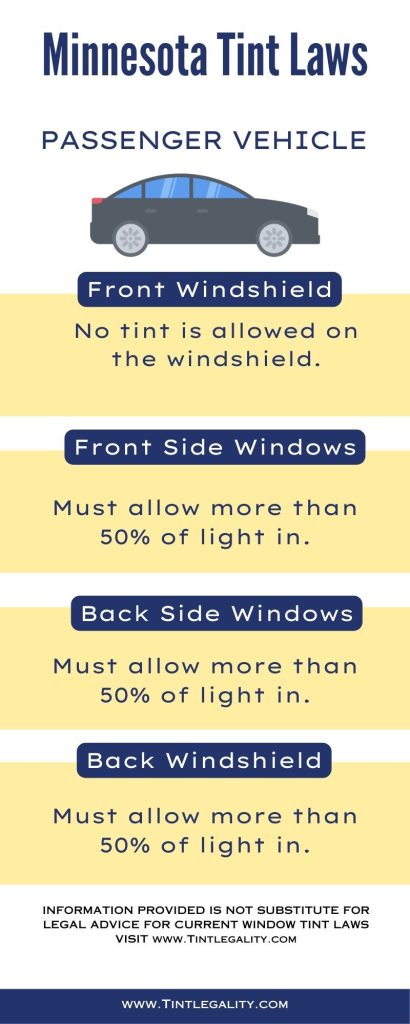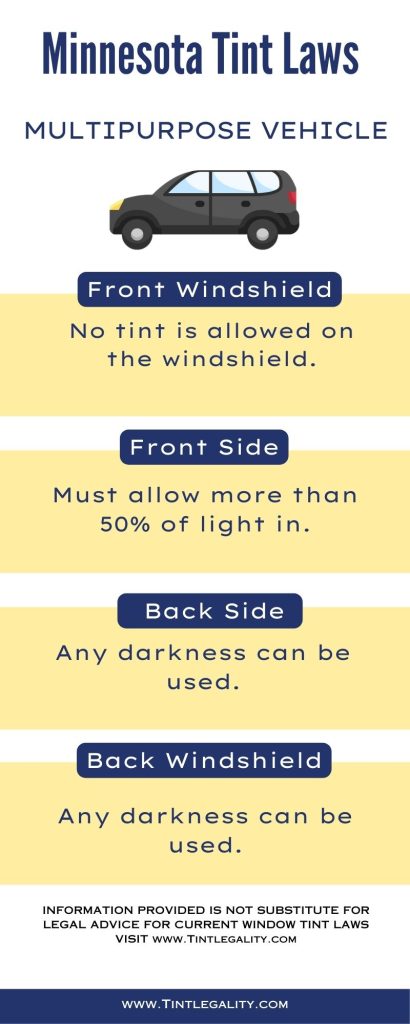When it comes to vehicle customization, window tinting is a popular choice, not only for aesthetics but also for safety and comfort.
But as with any modification, it’s essential to know the rules. That’s why we’re discussing “Minnesota Tint Laws” today.
These laws, enacted in 1985, guide how dark or reflective your car window tint can be in the state of Minnesota.
Regulations Regarding Window Tint in Minnesota
There are specific regulations for car window tinting in Minnesota, and these laws apply differently to various types of vehicles such as sedans, SUVs, and vans.
The MN laws specify how dark your window tint can be, as well as how much reflection is allowed.
It’s important to note that the regulations are different for the front side, backside, and rear windows.
| Vehicle Type | Windshield | Front Side Windows | Back Side Windows | Rear Window |
|---|---|---|---|---|
| Sedan | No Tint Allowed | More than 50% of VLT | More than 50% of VLT | More than 50% of VLT |
| SUVs/Vans | No Tint Allowed | More than 50% of VLT | No Restrictions | No Restrictions |
Windshield
In Minnesota, no tint is permitted on the windshield.
This is a standard regulation across many states, meant to ensure clear visibility for the driver.
After all, a clear view of the road is a basic safety requirement when driving.
Front Side Windows
In both sedans and SUVs or vans, front side windows must allow more than 50% of light in.
The intention here is to guarantee that drivers have adequate visibility of their surroundings.
Light is measured as a percentage of Visible Light Transmission (VLT), with a higher percentage indicating more light transmission.
Back Side Windows
For sedans, back side windows must also allow more than 50% light in.
However, for SUVs and vans, there’s a bit more flexibility with the darkness of the tint permitted on back side windows.
Rear Window
Like the back side windows, the rear window of a sedan should allow more than 50% light in.
But again, for SUVs and vans, there are no specified limits on how dark the tint can be.


Additional Regulations
Beyond tint darkness, Minnesota tint laws also cover other aspects. One of these is the reflectiveness of the tint.
The state mandates that front and back side windows must not be more than 20% reflective, regardless of the type of vehicle.
Reflection
Reflective tints are useful for reducing glare and heat, but too much reflection can be a safety hazard as it might blind other drivers.
That’s why Minnesota law specifies limits on window tint reflectiveness.
Medical Exemptions
Minnesota acknowledges that some individuals may need darker tints due to specific medical conditions.
In such cases, the state permits medical exemptions for special tints.
Color Restrictions
When it comes to the color of your window tint, Minnesota law is straightforward.
There are no colors of tint that are explicitly restricted for use.
Side Mirrors
Interestingly, there are no restrictions or requirements for side mirrors in Minnesota.
This allows vehicle owners to have more flexibility in customizing their cars.
Exceptions to Legal Limits
While the state has clearly defined limits for window tints, it also allows for a 3% variance in these limits.
This means that a slight deviation from the specified VLT and reflectiveness won’t necessarily put you on the wrong side of the law.
Penalties for Breaking the Law
But what happens if you don’t comply with the Minnesota tint laws?
The state has set specific penalties for any violation of these laws.
Fines
First, let’s talk about monetary penalties. The fines vary depending on the number of convictions:
- First Conviction: If this is your first offense, you’ll be looking at a certain fine.
- Second Conviction: The fine increases substantially for a second offense.
- Third Conviction: A third offense will cost you even more.
Other Penalties
Besides fines, there are other potential penalties for non-compliance with the Minnesota tint laws. These can range from having your tint removed to even facing jail time in extreme cases.
Understanding Minnesota Tint Laws and abiding by them is essential for all vehicle owners in the state.
The guidelines aim to balance personal preferences for customization with public safety requirements on the road.
Therefore, knowing these laws not only keeps you from running afoul of the regulations but also contributes to safer roads for everyone in Minnesota.
References: